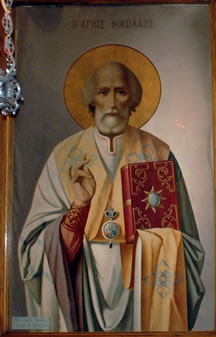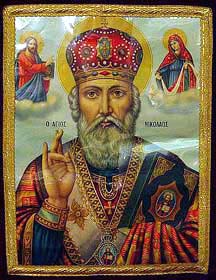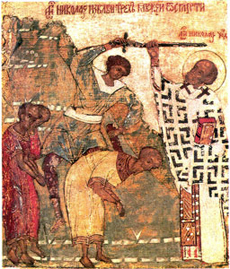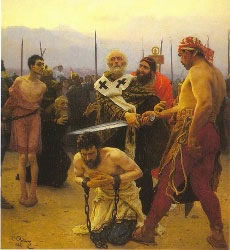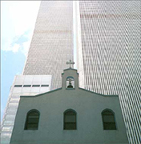|
.
The only house of worship destroyed in New York City on September 11, 2001 was a Greek Orthodox church named for St. Nicholas. To learn more, click these links: 1. The Greek Orthodox Archdiocese of America's September 11th Memorial Site 2. St. Nicholas Greek Orthodox Church, New York City, New York 3. The Greek Orthodox Archdiocese of America's 9/11 Memorial Brochure 4. Lower Manhattan Development Corporation (all design and rebuilding proposals for the World Trade Center site include rebuilding St. Nicholas Church on its original site) |
Yes Virginia, there is
a The title of this page is intended to be humorous, but it also points up the fact that of all the saints, Nicholas of Myra probably holds the strongest grip on the popular imagination. To most of us, Nicholas is best known as Santa Claus, the jolly old elf of the Yuletide season. He is also known in various guises in different countries as "Father Christmas," and the character of "The Ghost of Christmas Present," in Charles Dickens' classic A Christmas Carol, is obviously a variant of the British version of St. Nick. In Scandinavia, Nicholas is portrayed as wearing a western bishop's vestments and carrying a crozier instead of the red suit and bag that we traditionally associate with Santa Claus. In the Netherlands, Nicholas, as Sinter Klaas, again dresses as a western bishop (this time in a red robe trimmed in white fur, but still with miter and crozier) and traditional cookies called Speculaas (literally, "mirror," from the bas-relief molds used to form them) are baked for St. Nicholas Day. Children put out wooden shoes filled with hay to feed the saint's horse in hopes of receiving a small gift (or in hopes of not receiving a lump of coal for bad behavior). A number of surviving medieval miracle plays are based on the life of St. Nicholas, and St. Nick also shows up yearly in movies and television specials of widely and wildly varying quality (compare, for example, the classic 1947 movie A Miracle on 34th Street with a film like Santa Claus Conquers the Martians from 1964). In America in 1897, a little girl's letter to The New York Sun inspired Francis P. Church's famous editorial, "Yes Virginia, there is a Santa Claus!" and years later Robert L. Ripley, the creator of Ripley's Believe it or Not!, offended and enraged many parents by publishing a Believe it or Not! cartoon entitled "The Tomb of Santa Claus," which dealt factually (if not exactly tactfully) with the final resting place of the actual St. Nicholas in Bari, Italy. Much more recently, St. Nicholas has been spotted on the World Wide Web on websites such as The St. Nicholas Center and The St. Nicholas Society. And finally (if one can ever really use that word with St. Nicholas), as of this writing, the movie Nicholas of Myra, a biography of St. Nicholas, is currently in production. But the life story of the actual St. Nicholas of Myra (from the Greek words "nike," victory, and "laos," people -- literally, "victory of the people") is as fascinating as the myths, folklore, and traditions that have made the saint a popular culture icon over the centuries. As a child, Nicholas was instructed in the faith by his uncle, the Bishop of Patara, in Asia Minor. Eventually, Nicholas became a monk at a monastery founded by his uncle. It was during this time that Nicholas gave all of his money to the poor, and it is said that he saved a poor man's daughters from being given into prostitution by throwing bags of gold through an open window at night. This is where we find the basis for Santa Claus, the bringer of gifts on Christmas Eve. As a monk, Nicholas hoped for a life of solitude, but he was not to find one. One night, Nicholas dreamed that Jesus gave him a copy of the Gospels while Mary, the Theotokos, placed an omophorion on him. Jesus told Nicholas that rather than be a solitary monk, he must instead work among the people. In Myra, the archbishop died, and the committee responsible for choosing his successor could not reach an agreement. So they decided to fast and pray for enlightenment. It is said that an angel of God appeared to the presiding bishop and told him to select a man called Nicholas, who would be the first to arrive for morning prayers. Nicholas, a complete stranger in Myra, thus became bishop of Myra.
During the reigns of Diocletian and Maximian, Nicholas was persecuted and imprisoned for his faith, but continued to teach. After Constantine I legalized Christianity in the Roman Empire, the Arian controversy arose. Nicholas was one of the bishops attending the First Ecumenical Council at Nicaea (325), called to resolve the controversy. At the Council, Nicholas slapped Arius, a bishop from Alexandria, in the face for teaching that Christ was a created being instead of eternally one with the Father and the Holy Spirit. This resulted in Nicholas being deposed as bishop. However, several of the church fathers that night shared a dream in which they saw Nicholas reinstated as bishop by Christ and the Theotokos. The next day, Nicholas was reinstated as bishop and treated with respect. It is possible that this incident accounts for Nicholas' reputation as one who punishes bad children at Christmas (or on St. Nicholas' Day) as well as rewarding good children. Nicholas' reputation for charity continued throughout his lifetime, but the saint also had a reputation for justice. One story about Nicholas tells us that, while visiting a remote area, the saint received news that the ruler of Myra, Eustathius, had condemned three innocent men to death. Nicholas rushed home and arrived in time to physically intervene in the execution by grasping the executioner's sword and throwing it to the ground. He ordered the condemned men freed from their bonds. Approximately 1500 years later, in the 19th century, a controversy arose over capital punishment in Russia. Russian artist Ilya Repin studied ancient icons of Nicholas grasping the blade with his bare hand and used the images to make his own painting (in a realistic style instead of an iconographic style) depicting the incident and making his own comment about the controversy through art. Both a traditional icon of the incident and Repin's painting are reproduced at left. Click on the Repin painting to view a larger image. St. Nicholas died peacefully in Myra during the fourth century and was originally interred in a local church. His impact, as demonstrated above, has lasted far beyond his lifetime. Perhaps this is the greatest wonder performed by Nicholas the Wonder-Worker Apolytikion: A model of faith and the image of gentleness, the example of your life has shown you forth to your sheep-fold to be a master of temperance. You obtained thus through being lowly, gifts from on high, and riches through poverty. Nicholas, our father and priest of priests, intercede with Christ our God that He may save our souls. Kontakion: Saintly One, (St. Nicholas) in Myra you proved yourself a priest; for in fulfilling the Gospel of Christ, venerable One, you laid down your life for your people and saved the innocent from death. For this you were sanctified as One learned in divine grace.
|
